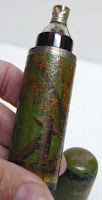 This comprehensive tutorial was generously contributed by my good friend Stefanie Deutsch, who has been collect- ing antique miniatures for more than ten years, and is currently working on a book on the subject. She is also the author of two books on vintage Barbie dolls: "Barbie, The First 30 Years" (published by Collector Books, the 3rd edition just printed) and "Barbie" (published in the German Battenberg Verlag).
This comprehensive tutorial was generously contributed by my good friend Stefanie Deutsch, who has been collect- ing antique miniatures for more than ten years, and is currently working on a book on the subject. She is also the author of two books on vintage Barbie dolls: "Barbie, The First 30 Years" (published by Collector Books, the 3rd edition just printed) and "Barbie" (published in the German Battenberg Verlag).
What to CollectThe field of miniatures is huge, encompassing everything from 17th century oils on copper to early 20th century watercolors on ivorine. While most collectors specialize, some are only interested in 20th century pieces, and others will buy anything of American origin,
children, beautiful ladies,
distinguished looking gents,
officers, signed paintings of known sitters, etc. This is truly a matter of taste, and there is no one area which "better" than another.
Where to BuyIf you have armed yourself with knowledge, and are able to form your own opinion (don't rely on sellers' descriptions alone), ebay is by far the best place to buy. If you need help (especially if you plan to spend thousands of dollars), your best bet would be the big UK auction houses, or reputable brick and mortar specialty antique shops. If you live in the rural UK (and are incredibly lucky), you might even find a miniature being offered by the family of the original sitter at a garage sale (boot sale). But don't waste your time at this type of venue, or, for that matter, flea markets. In my 10 years of collecting miniatures, I have never found anything this way.
Why Collect?I personally love 18th and early 19th century large scale portraits in oil. But how many of those can one hang in one's home? Many collectors live in small apartments, and just don't have the
wall space for large paintings. Miniatures have the quality of being "big art" on a small scale, with the added advantages of being easy to display, store, and ship. Miniature portraits are more than just something to collect. Each one represents a small piece of history, a mirror of its time. It is sometimes possible, with a little bit of sleuthing, to find out more about the sitter. But even pictures of anonymous sitters are a window to the fashion of the day, a way of life, and an epoch gone by. Also an important consideration for the collector is the investment potential. Many of the now high-priced mass produced modern collectables cater to only a single generation (who buy them for nostalgic reasons) and may not have any appeal to future generations. However, original pieces of art have always been collected and always will be. Like any other classic collectable, such as silver, fine porcelain, antique furniture, etc., miniature portraits go through "trend" cycles that influence their market value at any given time. In my opinion, miniatures are still very much undervalued at the moment; the cycle is on the upswing.
If you have enjoyed reading this tutorial and are interested in buying or selling miniature portraits, you can contact Stefanie at: sdeutsch@shaw.ca










































 Remember that old "American Express" slogan? Well, if you buy antiques ... and especially jewelry ... there is something you should NEVER be without. And that's the trusty LOUPE. No matter how good your eyesight is, you can't rely on the naked eye to see tiny flaws or read almost invisible hallmarks in small items.
Remember that old "American Express" slogan? Well, if you buy antiques ... and especially jewelry ... there is something you should NEVER be without. And that's the trusty LOUPE. No matter how good your eyesight is, you can't rely on the naked eye to see tiny flaws or read almost invisible hallmarks in small items. 
